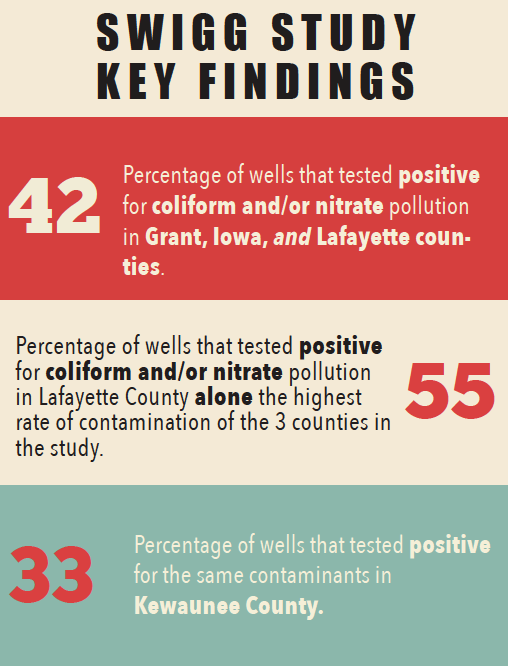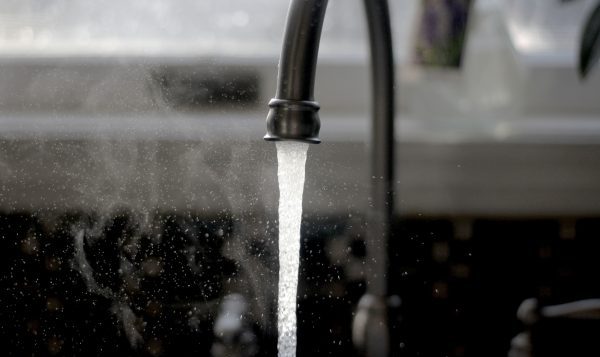SWIGG study results should be a call to action
The results from the first round of sampling for the Southwest Wisconsin Groundwater and Geology (SWIGG) study released earlier this month indicate serious problems with well water contamination in the region. For years, Clean Wisconsin has worked hard to push for strong drinking water protections, and these results confirm that we need bold action from local and state leaders to ensure every Wisconsin resident has access to clean drinking water.
In February, Governor Tony Evers announced he would allocate $75,000 for the SWIGG study in his state budget proposal. The measure is part of his commitment to address well water pollution during the Year of Clean Drinking Water, which he declared in his State of the State Address.
 The percentage of wells in Grant, Iowa, and Lafayette Counties that tested positive for coliform bacteria or above the safe level for nitrate was higher than the state average, with 42 percent of wells contaminated with one or both pollutants. By contrast, studies in Kewaunee County have found roughly 30% of wells testing positive for nitrates and/or bacteria.
The percentage of wells in Grant, Iowa, and Lafayette Counties that tested positive for coliform bacteria or above the safe level for nitrate was higher than the state average, with 42 percent of wells contaminated with one or both pollutants. By contrast, studies in Kewaunee County have found roughly 30% of wells testing positive for nitrates and/or bacteria.
I live in Lafayette County and drink from a private well every morning, and we test our well yearly for coliform and nitrates, since these pollutants pose serious health risks. To put it plainly, if my well tested at or above 10 mg/l for nitrate, my family and I would not drink the water.
The SWIGG Study results are the latest development of increased incidents of well water pollution—especially nitrate pollution—across the state, from Northeast to Central Wisconsin to the La Crosse area and now to Southwest Wisconsin.
Clean Wisconsin has been the leader in advocating for action from state leaders in Southwest Wisconsin for over two years, because the inconclusive data we had at the time suggested that well water pollution was a problem in these three counties.
With the clear results from the SWIGG study, now is the time for action, especially from the state. We are thrilled with the Governor’s bold response to match the funds local governments have already made to the SWIGG study. Currently, Grant, Iowa, and Lafayette Counties are funding the study.
Additionally, in response to the study results, Republican leadership have announced they will form a task force to study water quality around the state.
We shouldn’t wait to start talking about how we’re going to address this contamination, however.
Some farmers are already using cover crops and adjusting when they apply manure, both of which can help reduce the amount of nitrate that leaves the soil where our crops can access it and pollutes the groundwater.
In some places with very shallow soils and cracked bedrock, we might have to reduce the amount of nitrogen put on fields to try to find a compromise between maximizing yields and maintaining profitability and protecting drinking water. And changes to septic system design might also be in order.
As the SWIGG study continues, we’ll gain more valuable information on the scale and scope of contamination in Southwest Wisconsin and where the contaminants are coming from.
We already know, though, that the vast majority of nitrate in our groundwater comes from agricultural sources, though areas with a high density of septic systems can also contribute a substantial amount.
Clean drinking water is a public health issue and an economic issue. Everyone needs clean water to live healthy, high quality lives. Families and businesses in Southwest Wisconsin want to know the community cares about clean water and is willing to take action to protect it.
Some people might be tempted to focus on who to blame for our water woes. What’s more important is that we all work together to figure out how to fix the problems. We need farmers, residents, scientists, and our elected leaders to look at the facts, understand the problem, and find and support solutions together.
We may all have to make some sacrifices, but it is in service to a higher calling: making sure every family in our community can turn on the tap in the morning and safely drink the water.

Read next: Gov. Tony Evers declares 2019 the Year of Clean Drinking Water

